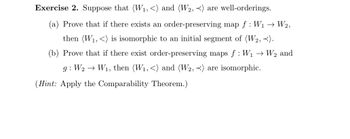
Elementary Linear Algebra (MindTap Course List)
8th Edition
ISBN: 9781305658004
Author: Ron Larson
Publisher: Cengage Learning
expand_more
expand_more
format_list_bulleted
Question

Transcribed Image Text:Exercise 2. Suppose that (W₁, <) and (W2, <) are well-orderings.
(a) Prove that if there exists an order-preserving map f: W₁W2,
then (W₁,<) is isomorphic to an initial segment of (W2, <).
(b) Prove that if there exist order-preserving maps f: W₁ →
g: W2 → W₁, then (W₁, <) and (W2, <) are isomorphic.
(Hint: Apply the Comparability Theorem.)
W2 and
Expert Solution
This question has been solved!
Explore an expertly crafted, step-by-step solution for a thorough understanding of key concepts.
Step by stepSolved in 2 steps

Knowledge Booster
Similar questions
- Find the kernel of the linear transformation T:R4R4, T(x1,x2,x3,x4)=(x1x2,x2x1,0,x3+x4).arrow_forward3. For each of the following mappings, write out and for the given and, where.arrow_forwardSuppose T: V --> W is a linear and surjective map and V and W are of finite dimension. Show that T has a linear right inverse, i.e., there is a linear map S: W --> V so that the composition T of S = Id. Explain your answer.arrow_forward
- 2. Suppose that G is a lincar map such that G(2,0) = (4, 0) and G(0, 3) = (–3, 9). Find the images of: (a) G(1,0) (b) G(1, 1) (c) G(2, 1)arrow_forwardSuppose that T:V→W is a linear map. Prove that T is one-to-one if and only if I maps linearly independen sets in V to linearly independent sets in W.arrow_forward(1) Given a subset U C V and a linear map T : V → V we say U is T-invariant if T(U) CU. Show that if U1, U2 C V are T-invariant subsets, then so is U1 + U2.arrow_forward
- 1. Let V = F∞ and consider the two linear maps T, S = L(F∞, F∞ defined by T(a1, A2, A3,... .) = (A2, A3, A4, ..). S(a₁, A2, A3, ...) = (0, A₁, A2, . . . ) Prove that TS = I, but ST ‡ I, where I is the identity in L(F∞, F∞).arrow_forward1arrow_forward1. Let T : R¹ → Rm be a linear transformation, and let {V₁, V2, V3} be a linearly dependent set in R. Explain why the set {T(v₁), T(v2), T(v3)} in Rm must also be linearly dependent. Remark: You argument should not be a “proof by example," that is, the argument should hold for arbitrary linear transformation T and arbitrary linearly dependent set of vectors {v₁, V2, V3} in Rº.arrow_forward
arrow_back_ios
arrow_forward_ios
Recommended textbooks for you
 Elementary Linear Algebra (MindTap Course List)AlgebraISBN:9781305658004Author:Ron LarsonPublisher:Cengage Learning
Elementary Linear Algebra (MindTap Course List)AlgebraISBN:9781305658004Author:Ron LarsonPublisher:Cengage Learning Linear Algebra: A Modern IntroductionAlgebraISBN:9781285463247Author:David PoolePublisher:Cengage Learning
Linear Algebra: A Modern IntroductionAlgebraISBN:9781285463247Author:David PoolePublisher:Cengage Learning Elements Of Modern AlgebraAlgebraISBN:9781285463230Author:Gilbert, Linda, JimmiePublisher:Cengage Learning,
Elements Of Modern AlgebraAlgebraISBN:9781285463230Author:Gilbert, Linda, JimmiePublisher:Cengage Learning,

Elementary Linear Algebra (MindTap Course List)
Algebra
ISBN:9781305658004
Author:Ron Larson
Publisher:Cengage Learning

Linear Algebra: A Modern Introduction
Algebra
ISBN:9781285463247
Author:David Poole
Publisher:Cengage Learning

Elements Of Modern Algebra
Algebra
ISBN:9781285463230
Author:Gilbert, Linda, Jimmie
Publisher:Cengage Learning,